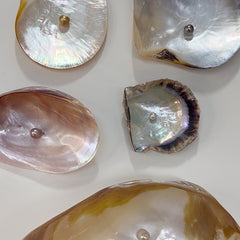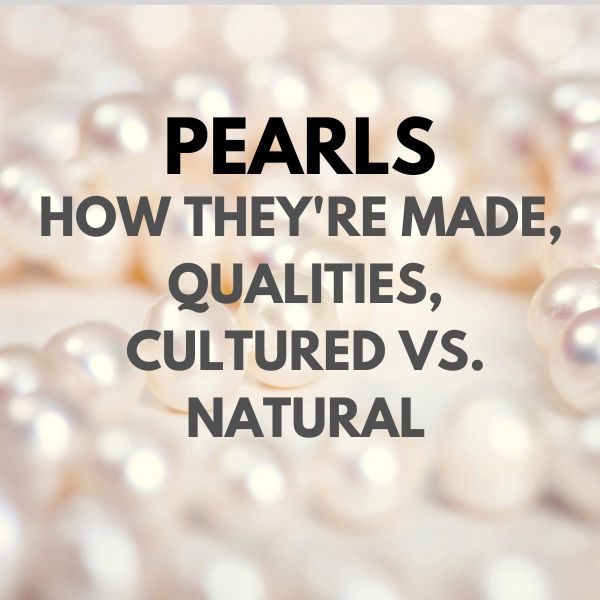Everything to Know about Pearls: How They're Made, Different Qualities, Cultured VS Natural, How To Clean
Shop our curated gemstone collection here
We will be covering everything you need to know about PEARLS so you can have a better understanding of how they're made, natural vs cultured, the different qualities, shapes, colored pearls and how to clean them! To inquire about a custom pearl necklace or jewel send us an email at info@fineandflux.com
How Are Pearls Made

Pearls are formed when a parasite enters the mollusk and causes an irritant. The oyster will then try to protect itself by secreting a substance called nacre, that envelopes the parasite and protects itself. Nacre is the same material of which the outer shell is composed.
In nature this occurrence is very rare. It is estimated you would need to sort
through 10,000 to 100,000 oysters before finding one pearl! This is why most pearls on the market today are farmed and the prices for natural are unattainable. To learn more about the market price of pearls click here.
How Are Cultured Pearls Made
Today almost all pearls found on the market are cultured (AKA farmed). In 1870 a Japanese man named Kokichi Mikimoto invented a way of recreating the natural process of making a pearl. He did this by inserting a bead made of nacre (same material as an oyster's shell) inside of the animal. This would trigger the same response of self-defense as when a parasite would enter their shell and nacre would be secreted, covering the nucleus, thus forming a pearl.
In using a round bead, pearl farmers were able to recreate a perfectly round pearl. Round pearls being the rarest shape to find in nature, became the most desired and thus expensive on the market.
How to Identify the Quality of a Pearl
Pearls, like gemstones, are evaluated on multiple factors such as luster, the thickness of the nacre, growth time, color and more. We will go over the most important aspects together so you can know what to look for when buying a strand of pearls! These factors apply for every type and shape of pearl.



1) A pearl's luster is one of the most important things to look for when buying a pearl. The luster is the shine given by the surface of a pearl, regardless of its shape. The more shine it has, the more valuable. In opposition, if a pearl is dull, it will bring down the price significantly. If you refer to the image to the left, you can clearly see the luster on the right pearl is of higher quality then the dull strand on the left.
2) The thickness of the nacre. Inside most shapes of cultured pearls we can find a nacre bead. This nucleus can be a multitude of sizes; what's important is the thickness of nacre the pearl produced over the bead. The thicker the surface, the longer it takes to produce, increasing the risk of the mollusk rejecting the nucleus and increasing the possibilities of superficial blemishes. Pearls can form for periods as short as 6 months all the way to 10 years for the highest quality.
3) The quality of the surface of the pearl. The surface must have as little imperfections as possible. These imperfections can include scratches, small irregularities such as pockets or dents, minor malformations that impact the shape. The image below is a perfect representation of poor-quality pearls (left) to a higher quality pearl (right), without blemishes.

The Different Shapes of a Pearl
Pearls come in a variety of shapes and sizes. The most valuable and desired shape is the round pearl, however there are many different shapes to consider to meet your style and price point! To learn more about the prices of each shape click here, or to request a quote send us an email at info@fineandflux.com
1) Round pearls: They are not only the most expensive due to their high demand but because to attain a high-quality surface to create a perfectly round pearl can be very hard.
2)Semi-round pearls: By the naked eye, they look round, but when rolling a strand across a flat surface you will see they do not roll smoothly. Semi-rounds will be significantly less than a round pearl, so when on a budget they may be a good alternative to consider.

3)Potato shaped pearls: The look exactly as the name described. They have a more elongated look similar to that of rice shaped pearl.

4)Baroque pearls: They are free formed pearls who take on more organic shape. They have a more unique look then the classic round one of our favorite shapes at Fine+Flux!

5)Button pearls: They have a round top and flat base. They're shaped like this because during their formation they happened to be closer to the edge of the shell, giving them less room to grow.

6) Fantasy shaped pearls: Pearls are more commonly made with a round nucleus because that's the most purchased, but you can actually make them with any shape nucleus. Take the pearls below for example. These cultured pearls had a variety of different shaped nucleuses: triangles, stars, squares. These are not the usual shape but could make very cute stud earrings or bracelets for young girls!

Colored Pearls : Are they Valuable?

Pearls come in a variety of colors. The more saturated and consistent the color the more valuable it becomes. The change in color is caused by the species of mollusk the pearl is coming from. For example, South Sea pearls produce beautiful golden pearls and Tahitian pearls produce black.
The changes in hues and saturations can be caused by the health of the mollusk, the salinity in the water, the different foods available and even the weather. This shows just how little control pearl farmers have over the production of pearls!
Aside from their natural colors, pearls can also be dyed. Contrary to popular belief, a dyed pearl is not worth less than its natural counterpart because for a pearl to be worth dyeing it must already be of high quality. Also, adding the additional labor of dyeing the pearls will increase the price.
How To Identify Fake Pearls
The easiest way to tell if a pearl is fake is to look around the pierced hole. A fake pearl needs to be pierced before its lustrous coating is applied. This causes for a pooling of product surrounding the hole. A natural pearl which will have a crisp edge around the rim of the opening. See image below for reference.

There are also small details you can observe, but require a trained eye. This is why we always recommend buying from a trusted jeweler with an extensive reputation. For pearls over $2K we do recommend asking for certification to insure you are getting the real deal!
How To Clean a Pearl Necklace or Jewelry
Pearls are delicate and require special care when it comes to cleaning and maintenance.
To clean your pearls all you need to do is take a soft cloth, dampen it with lukewarm water, and add a dab of very gentle soap (for example a soap used for babies). Then you can take your strand of pearls and gently pass over them with the dampened cloth. This will remove any buildup of debris on the surface of the pearls. Once you feel the pearls are cleaned, rinse your cloth free of soap and go over your pearls one last time and remove any soap that may have stayed on the pearls.

We even recommend cleaning your pearls with only warm water and keep the soap for when it is absolutely necessary.
Note: Never subdue your pearl necklace in water, for the string holding it together is made of silk and can be caused to stretch or even tear when saturated in water. Also for this reason, take care not to handle your pearls when wet as you do not want to damage the delicate silk.
Pearl Jewelry Maintenance & Care
One of the most important factors that contribute to the quality of a pearl is its luster. This is very important to remember because unlike gemstones which can be re-faceted (polished or cut) to re gain its brilliance after wear and tear, pearls cannot be re-polished to return to their original quality. They are an organic substance that can only be created within a mollusk, so if the surface of the pearl has been damaged there is no repair that can be done to your pearls.
With this in mind we have prepared a list of ways you can better care for your pearls, to keep them clean and beautiful forever!
- Always remove your pearl rings when using Purel (disinfectant) or washing your hands. Contact with these products can damage your pearls.
- When wearing a pearl necklace, only apply perfume to your wrists because the alcohol can damage your pearls.
- After every wear, take a clean, dry jewelry cloth and go over your pearls by gently wiping them down. In doing this every time you will help prevent a buildup of debris and will be able to keep them clean for longer!
- Store them separately from the rest of your jewelry. Pearls are soft, they only have a hardness of 2.5 to 4, meaning your other jewelry when in contact could easily scratch them. It can be as easy as wrapping them in a cloth before storing them or keeping them in a separate box.

Where Can You Buy a Pearl Necklace or Custom Jewel?
With us of course! It's really quite simple, all you need to do is send us a quick email at info@fineandflux.com, with your preferred color (for example; pink, cream, white), the size, the shape of your pearl and your budget. With this we will be able to sort through a selection of strands for you to choose from.
If you would like to learn more about how much peals cost, please head on over to our other blog!
.




